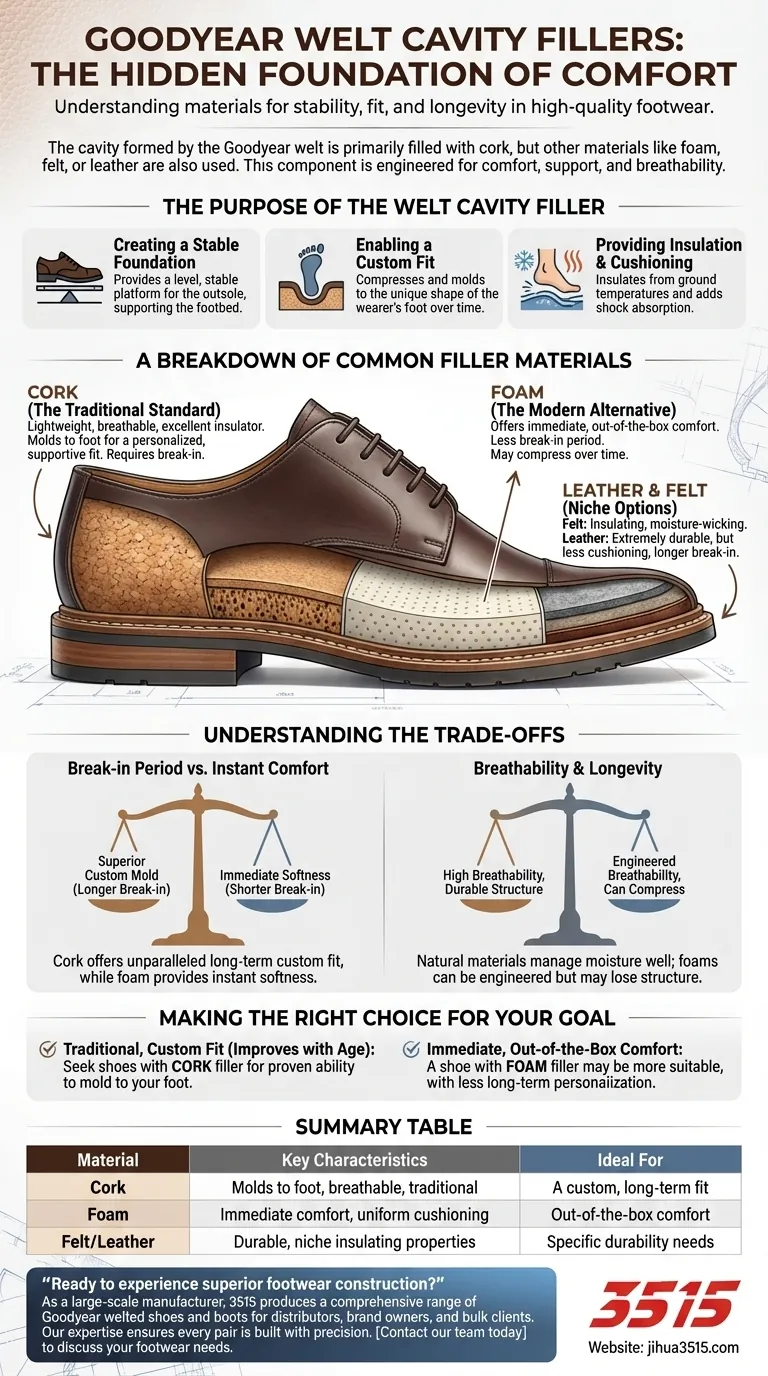The cavity in a Goodyear welted shoe is primarily filled with cork. This natural, lightweight material is the traditional choice because it gradually compresses and molds to the unique shape of the wearer's foot. While cork remains the standard in high-quality footwear, other materials like foam, felt, or leather strips are also used.
The filler material in a Goodyear welt is not just a void-filler; it is a functional component engineered for comfort, support, and breathability. The choice of this material directly dictates how the shoe will break in and adapt to your foot over its lifetime.

The Purpose of the Welt Cavity Filler
When a Goodyear welt is stitched to the upper and insole, it creates a small, empty space between the insole and the outsole. Filling this cavity is essential for the shoe's structure and performance.
Creating a Stable Foundation
The primary structural role of the filler is to create a level, stable platform for the outsole. Without it, the insole would be unsupported in the center, leading to a collapse of the footbed and an unstable walking experience.
Enabling a Custom Fit
The most celebrated feature of the filler is its ability to create a custom fit. As you wear the shoe, your body weight and the heat from your foot cause the material to compress, creating a perfect impression of your footprint.
Providing Insulation and Cushioning
The filler also provides a layer of insulation from the ground, protecting the foot from both cold and heat. It adds a degree of shock absorption that complements the rigidity of the leather or rubber outsole.
A Breakdown of Common Filler Materials
While several materials can be used, each has distinct properties that affect the shoe's feel and performance.
Cork: The Traditional Standard
Cork is the most common and revered filler material. It is lightweight, breathable, and an excellent insulator. Most importantly, it has a unique ability to mold to the foot over time without losing its supportive structure, providing a truly personalized fit.
Foam: The Modern Alternative
Some modern shoemakers use foam, often perforated for breathability. Foam offers more immediate, out-of-the-box comfort and requires less of a break-in period compared to cork.
Leather and Felt: Niche Options
Less frequently, strips of leather or layers of felt are used. Felt shares some of cork's insulating and moisture-wicking properties. Leather is extremely durable but offers less cushioning and a much longer break-in period.
Understanding the Trade-offs
The choice of filler material presents a direct trade-off between traditional break-in and modern convenience.
Break-in Period vs. Instant Comfort
Cork requires a break-in period. The initial stiffness gives way to a superior, custom-molded fit that many wearers find unparalleled. Foam, conversely, provides a softer, more uniform comfort from the very first wear but may not create the same personalized footbed.
Breathability and Longevity
Natural materials like cork and felt are inherently breathable and manage moisture well, which is crucial for foot health. While foams can be engineered for breathability, they may not perform as well as cork over the long term and can be more susceptible to compressing permanently over time.
Making the Right Choice for Your Goal
Understanding the filler helps you select a shoe based on its underlying construction principles.
- If your primary focus is a traditional, custom fit that improves with age: Seek out shoes that specify a cork filler for its proven ability to mold to your foot.
- If your primary focus is immediate, out-of-the-box comfort: A shoe using a modern foam filler may be more suitable, though it may not offer the same degree of long-term personalization.
By understanding this crucial component, you are equipped to choose footwear based not just on appearance, but on the very foundation of its comfort and quality.
Summary Table:
| Material | Key Characteristics | Ideal For |
|---|---|---|
| Cork | Molds to foot, breathable, traditional | A custom, long-term fit |
| Foam | Immediate comfort, uniform cushioning | Out-of-the-box comfort |
| Felt/Leather | Durable, niche insulating properties | Specific durability needs |
Ready to experience superior footwear construction? As a large-scale manufacturer, 3515 produces a comprehensive range of Goodyear welted shoes and boots for distributors, brand owners, and bulk clients. Our expertise ensures every pair is built with precision and the right materials for lasting comfort and quality. Contact our team today to discuss your footwear needs and discover how we can bring value to your business.
Visual Guide

Related Products
- Safety Footwear Wholesale Manufacturer for Custom OEM/ODM Production
- Durable Goodyear Welt Leather Work Boots for Wholesale & Private Label
- Durable Leather Work Boots for Wholesale & Custom OEM Manufacturing
- Durable Leather Work Boots for Wholesale & Custom Manufacturing
- Durable Leather Work Boots Wholesale Manufacturer & Custom Factory
People Also Ask
- How long can you wear safety boots? The Lifespan is Determined by Wear, Not Time
- Is safety-toe as good as steel toe? Choose the Right Protection for Your Job
- Is it normal to wear shoes in the house? A Guide to Hygiene, Comfort & Culture
- What are the cultural perspectives on wearing shoes in the house? A Guide to Home Etiquette & Hygiene
- What are OSHA approved shoes? Understanding the Correct Standards for Workplace Safety



















